
The Oslo Metro is the rapid transit system of Oslo, Norway, operated by Sporveien T-banen on contract from the transit authority Ruter. The network consists of five lines that all run through the city centre, with a total length of 85 kilometres (53 mi), serving 101 stations of which 17 are underground or indoors. In addition to serving 14 out of the 15 boroughs of Oslo, two lines run to Kolsås and Østerås, in the neighbouring municipality of Bærum. In 2016, the system had an annual ridership of 118 million.

Mortensrud is a rapid transit station on the Østensjø Line of the Oslo Metro. It is located in Mortensrud in the Søndre Nordstrand borough of Oslo, Norway. Construction of the station started in 1995, which was taken into use on 24 November 1997, when it became the terminal station of the line—following a 2.4 kilometres (1.5 mi) extension from Skullerud. The extension cost 215 million kr to build, and most of the section is in tunnels. The station is built in concrete, wood and stone, and cost NOK 35 million. It is served by line 3, in addition to being an important bus terminal for the borough, including a feeder service to Bjørndal. Travel time along the 13.6-kilometre (8.5 mi) section to the city center is 24 minutes. In 2001–02, the station had 2,077 daily boarding passengers. The station serves the surrounding residential area, as well as an adjacent shopping center. South of the station is a turning line for trains.
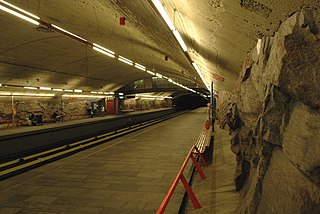
The Grorud Line is a 13.0-kilometer long (8.1 mi) line on the Oslo Metro between Tøyen and Vestli in Oslo, Norway. Built as a mix of underground, at ground level and as an elevated line, it runs through the northern part of Groruddalen, serving such neighborhoods as Grorud, Romsås and Stovner. Line 5 runs along the entire line four times per hour. Line 4 runs between Vestli and Økern before branching off on the Løren Line to get onto the Ring Line. With 40,000 daily riders, the Grorud Line is the busiest branch of the metro.

The Lambertseter Line is a 5.9-kilometer (3.7 mi) line on the Oslo Metro which runs from Brynseng to Bergkrystallen. It further shares track with the Østensjø Line along the 2.5-kilometer (1.6 mi) section from Tøyen to Brynseng. The line runs through a primary residential area of Nordstrand, serving neighborhoods such as Manglerud, Ryen and Lambertseter. The line is served by Line 4 of the metro, which runs every fifteen minutes. This is supplemented by Line 1 that is extended to Bergkrystallen between 6:30 and 19 on weekdays, giving a combined frequency of eight trains per hour.
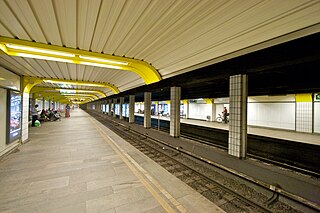
Grønland is a rapid transit station on the Oslo Metro in the Common Tunnel serving all six lines. It is located in the business and residential area Grønland, between the stations Jernbanetorget to the west and Tøyen to the east. The station was opened on 22 May 1966 with the opening of the subway, and underwent refurbishments 1988–92. Peer Qvam was the original architect.

Ryen is a station on Lambertseter Line of the Oslo Metro. It is between Manglerud and Brattlikollen, and located in the Nordstrand borough where the Lambertseter Line crosses the E6 highway. Ryen Depot is a workshop and train yards for the subway company, therefore Ryen is a station where some early morning trains originate and some late evening trains terminate. During the early morning on weekdays, all lines serve Ryen, between 4:30 to 5:30.
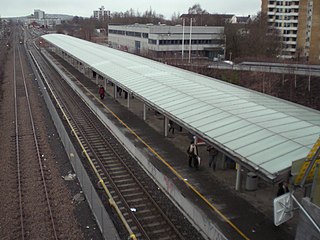
Storo is a rapid transit station on the Ring Line of the Oslo Metro, and a tram station on the Grünerløkka–Torshov Line of the Oslo Tramway. It is located at Storo in the Nordre Aker borough of Oslo, Norway. The tram station opened on 28 November 1902, and the rapid transit station on 20 August 2003. Metro lines 4 and 5 run to the station. The tram station serves lines 11, 12 and 18. The station is within walking distance of Grefsen Station on the Gjøvik Line. The station also functions as a bus hub, being located along Ring 3. Storo is a mixed commercial and residential area, and a shopping center is located just north of the subway station.

Lambertseter is a station on Lambertseter Line on the Oslo Metro, served by Line 4. It is located between Karlsrud to the north and Munkelia to the south.
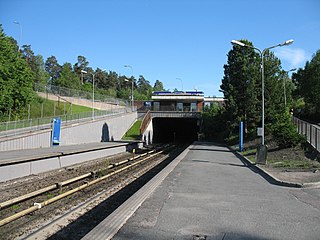
Munkelia is the second last station on Lambertseter Line of the Oslo Metro, between Lambertseter and Bergkrystallen, 10.0 km (6.2 mi) from Stortinget. The station is served by Lines 1 and 4. The station is located just north of the entrance of one of the few tunnels on this subway line. The entrance to the two platforms is to the south.

Sinsen is a rapid transit station on the Ring Line of the Oslo Metro. It is located at Sinsen in the Sagene borough of Oslo, Norway. Next to the station is the tram station Sinsenkrysset, that has been part of the Sinsen Line of the Oslo Tramway since 1939. The station opened on 20 August 2006, as part of the first section of the Ring Line. The station is served by line 4 and 5 of the metro, as well as several local bus services. Sinsen is a mixed residential and commercial area.

Lindeberg is an Oslo Metro station on the Furuset Line between Trosterud and Furuset. The station was opened on 19 February 1978 with the opening of the Trosterud-Furuset stretch of the line. The station is located underground. The area is residential, but there is also a small hill for downhill skiing, Jerikobakken, in the vicinity.

Høyenhall is a rapid transit station on the Lambertseter Line of the Oslo Metro. Served by Line 4, it is the first station on the Lambertseter Line not shared with any other line. It is located between Brynseng and Manglerud, 5.2 kilometres (3.2 mi) away from Stortinget.

Bøler is a station on Østensjø Line on Norway's Oslo Metro system between the stations of Ulsrud and Bogerud, 9.2 kilometers (5.7 mi) from Stortinget, in the area of the same name. The station opened as a subway station on 29 October 1967, but rail service to Bøler started already in 1958 as part of the city's tram network.

Brattlikollen is a station on Lambertseter Line of the Oslo Metro. The station is between Ryen and Karlsrud, 7.8 km (4.8 mi) from Stortinget. The station was opened on 28 April 1957 as a tramway and on 22 May 1966 as a metro. The station's architect was Edgar Smith Berentsen.

Holmen is a station on the Røa Line of the Oslo T-bane system. It is located between Makrellbekken and Hovseter and serves the neighbourhood of Holmen. The station is 6.1 km from Stortinget. Holmen was opened on 24 January 1935 when the line was completed to Røa. The station is at an altitude of 119.4 metres above sea level. The station is located in a mainly residential area.

Manglerud is a rapid transit station on the Lambertseter Line of the Oslo Metro. It is served mainly by line 4 and by line 1 trains on weekdays between 06:00 and 19:00. It is located between Høyenhall and Ryen, 6.2 kilometres (3.9 mi) from Stortinget.

Karlsrud is a station on Lambertseter Line of the Oslo Metro, on the north side of Lambertseter. The station is between Brattlikollen and Lambertseter, 8.6 kilometers (5.3 mi) from Stortinget. The station was opened on 28 April 1957 as a tramway and 22 May 1966 as a metro. The station's architect was Guttorm Bruskeland.

Hauketo Station is a railway station on the Østfold Line. It is located in the Hauketo neighborhood in the Søndre Nordstrand borough of Oslo, Norway. Situated 8.68 kilometers (5.39 mi) from Oslo Central Station, it features two side platforms. Hauketo is served by the Line L2 of the Oslo Commuter Rail, providing two to four services each hour.
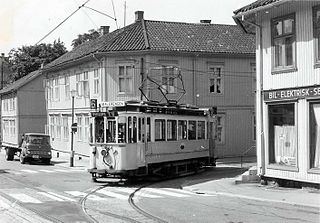
The Vålerenga Line, also known as Helsfyr Line and Etterstad Line, is an abandoned line of the Oslo Tramway of Norway. It branched from the Gamlebyen Line in Schweigaards gate and ran into the neighborhoods of Vålerenga, Etterstad and Helsfyr. The line followed the streets of Schweigaards gate, St. Halvars gate, Enebakkveien, one direction each in Vålerenggata and Strømsveien, and Etterstadgata. The line continued as a suburban light rail as the Østensjø Line and the Lambertseter Line.




















